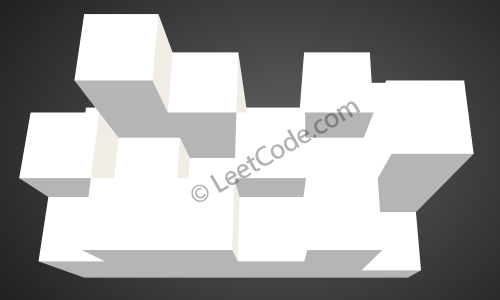Given an m x n matrix of positive integers representing the height of each unit cell in a 2D elevation map, compute the volume of water it is able to trap after raining.
Note:
Both m and n are less than 110. The height of each unit cell is greater than 0 and is less than 20,000.
Example:
Given the following 3x6 height map: [ [1,4,3,1,3,2], [3,2,1,3,2,4], [2,3,3,2,3,1] ] Return 4.

The above image represents the elevation map [[1,4,3,1,3,2],[3,2,1,3,2,4],[2,3,3,2,3,1]] before the rain.

After the rain, water are trapped between the blocks. The total volume of water trapped is 4.
fb : 考过一
Analysis, 根据木桶原理,先找外围最矮的bar,里边如果有bar比它还矮,一定能存水(因为四周所有的bar都比它高)
注意还可能存更多的水,因为往里面,很可能cell高度变化。所以要把BFS中间遇到的高的bar都存进queue,随着水平面提升,提升到这些bar的高度,看能不能有凹槽存更多的水
44-45行逻辑就是
if (height[row][col] < cur) {
res += cur.height- height[row][col];
queue.offer(new Cell(row, col, cur.height));
}
else {
queue.offer(new Cell(row, col, height[row][col]));
}
public class Solution {
public class Cell {
int row;
int col;
int height;
public Cell(int row, int col, int height) {
this.row = row;
this.col = col;
this.height = height;
}
}
public int trapRainWater(int[][] heights) {
if (heights == null || heights.length == 0 || heights[0].length == 0)
return 0;
// 创建heap,时复写comparator, 因为里面的元素时cell, 需要明确compare方法比较的内容
PriorityQueue<Cell> queue = new PriorityQueue<>(1, new Comparator<Cell>(){
public int compare(Cell a, Cell b) {
return a.height - b.height;
}
});
int m = heights.length;
int n = heights[0].length;
boolean[][] visited = new boolean[m][n];
// Initially, add all the Cells which are on borders to the queue.
for (int i = 0; i < m; i++) {
visited[i][0] = true;
visited[i][n - 1] = true;
queue.offer(new Cell(i, 0, heights[i][0]));
queue.offer(new Cell(i, n - 1, heights[i][n - 1]));
}
for (int i = 0; i < n; i++) {
visited[0][i] = true;
visited[m - 1][i] = true;
queue.offer(new Cell(0, i, heights[0][i]));
queue.offer(new Cell(m - 1, i, heights[m - 1][i]));
}
// from the borders, pick the shortest cell visited and check its neighbors:
// if the neighbor is shorter, collect the water it can trap and update its height as its height plus the water trapped
// add all its neighbors to the queue.
int[][] dirs = new int[][]{{-1, 0}, {1, 0}, {0, -1}, {0, 1}};
int res = 0;
while (!queue.isEmpty()) {
Cell cell = queue.poll();
for (int[] dir : dirs) {
int row = cell.row + dir[0];
int col = cell.col + dir[1];
if (row >= 0 && row < m && col >= 0 && col < n && !visited[row][col]) {
visited[row][col] = true;
res += Math.max(0, cell.height - heights[row][col]);
queue.offer(new Cell(row, col, Math.max(heights[row][col], cell.height)));
}
}
}
return res;
}
}
这里是矩阵, 在构建图时不需要用map来存储键值对以达到遍历的目的, 但是需要有元素大小的比较, 因此用heap, 与
399. Evaluate Division 数据结构, 算法也不同, 一个是map 上的dfs, 一个是矩阵上的bfs, 一个是要找到一条自始至终的路径, 一个是遍历完所有相邻的点求值(根据题意)
但是bfs要点在于如何建图, 是否建类, 建比较器, 建方向容器, 建走过的路的存储器(数组, 或者set, list) 如何遍历(堆不空?), 遍历到内部的点时判断是否符合题意(边界, 走过), 再考虑题意, 判断当前的点是否符合题意来加入结果的容器 或结果值, 将当前的点加入堆中是否要改变值啊什么的, 关键在于建立的是什么图. 里面的点是怎么个意思, 都是题意的转化